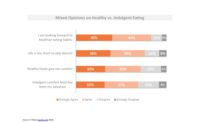The latest Culinary Visions study in The Mindful Dining Initiative focuses on the impact of the COVID-19 outbreak on dining habits and preferences of consumers across the United States. In this new study over 2,600 consumers were surveyed to delve into how the pandemic has impacted the way they eat today and their expectations for the future.
“The pandemic has shifted everyone’s eating habits, from the venues they can access to the types of meal experiences available,” said Sharon Olson, executive director of Culinary Visions. “With so much in limbo, consumers are looking for hands-on ways to regain control over their food choices wherever they can.”
In 2014, the Mindful Dining Initiative noted consumers were using technology and social networks to fuel their decision making and help them make more mindful choices about what they chose to eat and drink. This behavioral aspect of the trend has accelerated exponentially in the ensuing years and the latest wave shows consumers are using their knowledge and access to information to maintain control over their meals.
The pandemic has made everyday life something that is very much out of control for the vast majority of Americans, yet the new study shows food choices and mealtimes are a source of comfort and empowerment for consumers. Consumers are prioritizing foods they enjoy as the standard for self-care at mealtime with 74 percent agreeing that eating food they feel good about is more important to their wellness than watching their weight.
Pandemic era consumers are taking an active interest in preparation of their meals. 85 percent of participants prefer meals they prepare themselves. Additionally, 72 percent of participants would rather buy items from a deli to prepare at home, rather than have an item prepared by the staff. Even when picking up food from a third party, consumers still want to add the finishing touches to their meals.
Consumers continue to place a high value on information about the food they are consuming. 79 percent want to know as much as possible about what they are eating from food sourcing to preparation. Past Mindful Dining studies have revealed similar patterns in consumers’ transparency seeking behavior. In 2015, when asked whether certain food claims would influence their decision to purchase an item, respondents were overwhelmingly influenced by descriptive food labeling. 73 percent of consumers agreed that the term “local” would influence their purchase and 60 percent were influenced by the phrase “hormone free.” By 2018 “fresh” was identified as the most influential menu term with 86 percent of consumers surveyed saying it impacted their choices. The 2018 study focused on restaurant dining behaviors and 70% of consumers surveyed said they relied on their friends and family as sources of information for where to dine.
Click here to view the full infographic.









